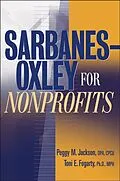A complete guide to leveraging the power of
Sarbanes-Oxley--specifically for nonprofits
The first book to discuss the implications of Sarbanes-Oxley
legislation as it relates to nonprofit organizations,
Sarbanes-Oxley for Nonprofits is an essential guide for all
nonprofit executives and boards who want to know how the new
legislation can enhance their organization's mission.
By establishing a "platinum standard" of operations and governance
within nonprofit organizations, executives and board members will
be better equipped to attract high-quality staff and board members,
as well as the attention of donors and other potential funding
sources. Sarbanes-Oxley for Nonprofits presents the best practices
that have emerged from the Public Company Accounting Reform and
Investor Protection Act (Sarbanes-Oxley) in a manner that explains
their source and value to the nonprofit organization.
Written for both small and large nonprofits, Sarbanes-Oxley for
Nonprofits includes:
* Practices intended to establish a "platinum standard" of
operations and governance within the nonprofit
* Coverage of audits, financial statements, board activities and
decision making, how to teach board members to read and interpret
financial statements, conflicts of interest, whistle-blower
protection, and how to leverage these standards to gain a
competitive advantage
* Sarbanes-Oxley best practices and the organizational
culture
* Sample documents, forms, and checklists to introduce these best
practices into any nonprofit organization
* And much more!
Autorentext
PEGGY M. JACKSON, DPA, CPCU, is a consultant and nationally
recognized lecturer in risk management, business continuity
planning, and Sarbanes-Oxley compliance for nonprofits. Dr. Jackson
has coauthored five books on risk management in nonprofit
organizations: Managing Risk in Nonprofit Organizations (Wiley);
Mission Accomplished: A Practical Guide to Risk Management for
Nonprofits; Mission Accomplished: The Workbook; No Surprises:
Harmonizing Risk & Reward in Volunteer Management; and Risk
Management for School Principals: A Workbook. She is a partner with
Fogarty, Jackson & Associates and a principal with Adjunct LLC
in San Francisco, California.
TONI E. FOGARTY, PhD, MPH, is an assistant professor in the
Department of Public Affairs and Administration at California State
University, East Bay. She serves as the graduate coordinator for
the Master of Science in Health Care Administration program, and
teaches courses in healthcare management, organizational change and
development, healthcare finance and budgeting, research methods,
and the legal and ethical aspects of healthcare. She is a founding
partner and CFO of Fogarty, Jackson & Associates, a consulting
group that provides consulting services in the areas of risk
management, business continuity planning, injury and illness
prevention programs, and distance education and training. She has
been published in several professional and academic journals and
has made a number of presentations at national and international
conferences. In addition, she coauthored the textbook Managing Risk
in Nonprofit Organizations (Wiley).
Zusammenfassung
A complete guide to leveraging the power of Sarbanes-Oxley--specifically for nonprofits
The first book to discuss the implications of Sarbanes-Oxley legislation as it relates to nonprofit organizations, Sarbanes-Oxley for Nonprofits is an essential guide for all nonprofit executives and boards who want to know how the new legislation can enhance their organization's mission.
By establishing a "platinum standard" of operations and governance within nonprofit organizations, executives and board members will be better equipped to attract high-quality staff and board members, as well as the attention of donors and other potential funding sources. Sarbanes-Oxley for Nonprofits presents the best practices that have emerged from the Public Company Accounting Reform and Investor Protection Act (Sarbanes-Oxley) in a manner that explains their source and value to the nonprofit organization.
Written for both small and large nonprofits, Sarbanes-Oxley for Nonprofits includes:
* Practices intended to establish a "platinum standard" of operations and governance within the nonprofit
* Coverage of audits, financial statements, board activities and decision making, how to teach board members to read and interpret financial statements, conflicts of interest, whistle-blower protection, and how to leverage these standards to gain a competitive advantage
* Sarbanes-Oxley best practices and the organizational culture
* Sample documents, forms, and checklists to introduce these best practices into any nonprofit organization
* And much more!
Inhalt
Acknowledgments.
About the Authors.
Preface.
Chapter 1: Overview of the Legislation and Its Implications for Nonprofits.
What Is the Sarbanes-Oxley Legislation About?
Relevance of SOX to Nonprofits.
Current Legislative Environment for Nonprofits.
Conclusion.
Endnotes.
Chapter 2: Safeguarding Your Nonprofit's Financial Resources and Assets: Establishing Auditor Independence and Audit Committee Competence.
SOX Titles II and III.
The Value of Accurate Financial Statements.
The Importance of a Good Audit.
The Board's Responsibility Regarding the Financial Statements.
Conclusion.
Chapter 3: Reading and Interpreting Financial Statements.
Balance Sheet.
Statement of Operations.
Statement of Changes in Net Assets.
Statement of Cash Flows.
Financial Statement Analysis.
Conclusion.
Chapter 4: Form 990: Unnecessary Paperwork or a Useful Tool?
What Are Form 990 and Form 990-EZ?
Why Is Form 990 Important?
Management's Role in Improving Form 990: Creating a Good Internal Control System.
The Board's Role in Form 990.
Conclusion.
Chapter 5: SOX Sections VIII and XI: Document Retention and Whistleblower Protection Obligations.
Whistleblower Protection.
Creating a Confidential Reporting System.
Document Retention, Archiving, and Retrieval.
First Steps: Beginning the Process.
Conclusion.
Chapter 6: >Raising the Bar of Accountability: SOX Best Practices and the Board.
Legislative Environment: Best Practices and Governance.
New Expectations for Board Oversight and Governance.
Higher Expectations for Board Membership and Deliberations.
SOX and the Board: Higher Performance and Greater Accountability.
Championing SOX Best Practices: The Board's Governance Role.
Conclusion.
Chapter 7: SOX Best Practices and Organizational Culture: Changing the Environment.
The Nonprofit's Organizational Culture and the Adaptation of SOX Best Practices.
Introducing Change.
Nonprofit Board Culture.
Strategies for Introducing Change in the Board Culture.
Conclusion.
Endnote.
Chapter 8: A Platinum Operating Standard Starts with Good Bones.
SOX Best Practices: Moving to a Platinum Operating Standard.
What Are Platinum Operating Standards?
Review of Internal Controls.
Conducting the Review of Internal Controls.
Content and Structure of the Review of Internal Controls Report.
Conclusion.
Endnote.
Chapter 9: Creating a Competitive Advantage: Leveraging SOX Best Practices.
Competitive Advantages of Being in Compliance with Sarbanes-Oxley Best Practices.
Conclusion.
<…